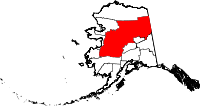Yukon–Koyukuk Census Area
| Yukon-Koyukuk Census Area, Alaska | |
|---|---|

|
|
 Location in the U.S. state of Alaska |
|
 Alaska's location in the U.S. |
|
| Established | 1980 |
| Largest city | Fort Yukon |
| Area | |
| • Total | 147,805 sq mi (382,813 km2) |
| • Land | 145,505 sq mi (376,856 km2) |
| • Water | 2,300 sq mi (5,957 km2), 1.6% |
| Population (est.) | |
| • (2016) | 5,526 |
| • Density | 0.04/sq mi (0/km²) |
| Congressional district | At-large |
| Time zone | Alaska: UTC-9/-8 |
Yukon-Koyukuk Census Area is a census area in the U.S. state of Alaska. As of the 2010 census, the population was 5,588. It has the largest area of any county or county-equivalent in the United States. It is part of the unorganized borough of Alaska and therefore has no borough seat. Its largest communities are the cities of Galena, in the west, and Fort Yukon, in the northeast.
According to the U.S. Census Bureau, the census area has 147,805 square miles (382,810 km2), of which 145,505 square miles (376,860 km2) is land and 2,300 square miles (6,000 km2) (1.6%) is water. The area is roughly the same size as the U.S. state of Montana or the country of Germany. The area is bigger than 47 of the 50 states, with only California, Texas and Alaska itself being bigger than the county size. Its population density, at 0.0449 inhabitants per square mile (0.0173/km2), is the lowest in the United States.
As of the census of 2000, there were 6,551 people, 2,309 households, and 1,480 families residing in the census area. The population density was 22.3 square miles (57.7km2) per person. It is the least densely populated county-equivalent of all 3,141 county-equivalents of the United States. There were 3,917 housing units at an average density of 0.027 per square mile (0.010/km2). The racial makeup of the census area was 24.27% White, 0.09% Black or African American, 70.89% Native American, 0.37% Asian, 0.05% Pacific Islander, 0.43% from other races, and 3.91% from two or more races. 1.19% of the population were Hispanic or Latino of any race. 12.95% reported speaking an Athabaskan language at home; of these 35.26% speak Gwich’in and 10.94% speak Koyukon.
...
Wikipedia
